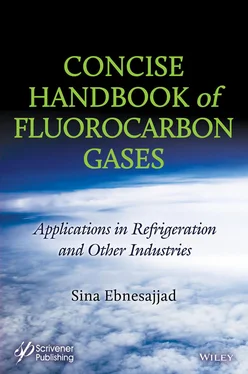2. Sato, K., Naturally Occurring Organic Fluorine Compounds , Tokyo Chemical Industry, April 2016, www.tcichemicals.com.
3. US Patent 1,978,840, A. L. Henne, assigned to General Motors Corp, Oct. 30, 1934.
4. US Patent 2,192,143, T. Midgley, Jr., A. L. Henne, assigned to Kinetic Chemicals Co., Feb. 27, 1940.
5. US Patent 2,062,743, H. W. Daudt, M. A. Youker, assigned to Kinetic Chemicals Co., Dec. 1, 1936.
6. Blasing, T.J. and Jones, S., Environmental Sciences Division , Oak Ridge National Laboratory, doi: 10.3334/CDIAC/atg.033, February 2012.
7. Daikin Industries, Fluorocarbon, www.daikin.com/chm/products/fluorocarbon, May 2016.
8. Refrigerants Environmental Data , The Linde Group, www.linde-gas.com, April 2020.
9. Ashford, P. et al. , Chapter 7, Emissions of Fluorinated Substitutes for Ozone Depleting Substance, in: Processes and Product Use , vol. 3, IPCC Guidelines for National Greenhouse Gas Inventories, www.ipcc-nggip.iges.or.jp, 2006.
10. ASHRAE Standard, ANSI/ASHRAE Addenda z, ah, ai, and aj to ANSI/ASHRAE Standard 34-2007, www.ashrae.org, Jan 27, 2010.
11. Smith, M.B. and March, J., March’s Advanced Organic Chemistry - reactions, mechanism and Structure , John Wiley & Sons, 2007.
12. Ebnesajjad, S., Introduction to fluoropolymers: materials, technology, and applications , 2 nded, Elsevier, New York, 2020.
13. Ebnesajjad, S., Fluoroplastics Vol 1 – Non-melt Processible Fluoropolymers , 2 nded, Elsevier, 2015.
14. Ebnesajjad, S., Fluoroplastics Vol 2 – Melt Processible Fluoropolymers , 2 nded, Elsevier, 2015.
15. Kynar ®PVDF Fluoropolymer Family, Arkema High Performance Polymers, http://americas.kynar.com, 2020.
16. U.S. Patent 2,810,702, M.F. Bechteld and M. I. Bro, assigned to Du Pont Co, October 22, 1957.
17. Fluoropolymers Market - Global Industry Trends & Forecasts to 2019 www.marketsandmarkets.com, May 2016.
3
Fluorine Sources and Basic Fluorocarbon Reactions
Fluorine represents the most extreme of all elements [1]. It is the most reactive element known to man. It reacts with glass and nearly everything else. Even noble gases such as xenon, krypton and gold are not safe because every one of them reacts with fluorine. Fluorine is quite unique among all other elements because of its properties. It carries its uniqueness into organic substances when fluorine substitutes hydrogen and other elements in their molecules. The first synthesis of fluorine has been attributed to Moissan who exhibited the reactivity of fluorine [2].
The impact of fluorine on other materials, nicknamed superhalogen , is more severe than that of other halogens including chlorine. This chapter describes fluorine ores and the basic chemistry of reactions to produce organic fluorine compounds. Narrow aspects of fluorine chemistry related to the preparation of commercial fluorinated alkanes are discussed. An overview of the polymerization of fluorinated oleffinic monomers is also reviewed. The readers should consult the books and articles cited in this chapter for a broader understanding of fluorine chemistry.
3.1 Role of Fluorine in Fluorocarbons
Fluorine is the most electronegative of all elements at electronegativity of 4 in Pauling units. Electronegativity of other elements are 3.4 for oxygen, 3.2 for chlorine, 2.6 for carbon and 2.2 for hydrogen (Table 3.1) [3]. Extreme electronegativity of fluorine renders its covalent bonds highly polarized such as in C-F. Consequently, fluorine gas attacks nearly every substance and chemical because of very high reactivity. It even attacks noble gases like xenon producing XeF x. It is easy to fluorinate hydrocarbons by fluorine gas, but the intensity of this reaction is too severe to control and causes broad decomposition.
The shortest bond is formed between C and H (0.11 nm) followed by C-F at 0.14 nm. Van der Waals radius (r w) of fluorine substituent is 0.147 nm, shorter than in any other substituent. Van der Waals radius refers to the radius of an imaginary sphere that an atom occupies. The short bond length and r wprevent the development of steric strain in perfluorinated compounds contributing to high thermal stability [3].
Carbon and fluorine form one of the strongest covalent bonds with an average bond energy around 480 kJ/mol. It exceeds the strength of carbon bond with other halogens (Table 3.2). C-F strength is one of the important reasons for high thermal and chemical stability of organic fluorochemicals. The F atoms have just the right size to create a protective shield (or sheath) over the carbon backbone when it is attached directly to the chain like in polytetrafluoroethylene (PTFE). If the F atoms were any smaller or larger than they are, the sheath would not form a regular uniform cove. This F shield protects the carbon chain from attack and confers chemical inertness and stability to PTFE. Fluorinated chemical groups play a similar role in hydrocarbons [5].
Table 3.1Atomic properties of fluorine and other elements [4].
| Element |
Van der Waals, radii, nm |
Electronegativity, Pauling |
| F |
0.147 |
3.98 |
| O |
0.152 |
3.44 |
| N |
0.155 |
3.04 |
| C |
0.170 |
2.55 |
| H |
0.120 |
2.20 |
Table 3.2Atomic properties of fluorine and other elements [4].
| Element |
Average bond strength, kJ/mol |
Average bond length, nm |
| C-F |
485 |
0.139 |
| C-C |
356 |
0.153 |
| C-O |
336 |
0.143 |
| C-H |
416 |
0.109 |
Fluorine is the 13 thmost common element on the Earth but it occurs virtually only as inorganic compounds. There are three industrially significant fluorine minerals: fluorite or fluorspar, fluorapatite and cryolite. Fluorspar consists of CaF 2, seen in Figure 3.1 and comes in two grades. The more pure variety is called acid grade and is used for HF production. The other fluorspar grade (lower) is used in metallurgy in iron and steel casting, primary aluminum production, glass manufacture, enamels; welding rod coatings, cement production, as a flux in steelmaking and in other applications [6].
Fluorapatite or fluoroapatite is a phosphate with the chemical formula of Ca 5(PO 4) 3F [Figure 3.1(b)]. It is the most abundant fluorine ore but it contains little fluorine. The third fluorine mineral Cryolite [Figure 3.1(c)] has a chemical formula of Na 3AlF 6, used in aluminum production. Cryolite has the highest amount of fluorine but it is a relatively scarce ore.
The dynamics of supply and consumption of fluorspar are quite complex. Fluorspar price and annual consumption/import for the United States is presented in the rest of this section. Figure 3.2 is helpful in clarification of some of the issues relevant to fluorspar. Some of the factors impacting the imported quantities and the prices are listed below:
1 The general economy and business cycle such as recessions and booms.
2 Demand for fluorinated and other materials that requiring HF.
3 United State stopped production of fluorspar after 1996.
4 USA has been importing acid grade fluorspar mostly from China, Mexico and South Africa. These three countries are the major three producers of CaF2 in the world.
5 During the early years post stoppage of domestic fluorspar China was the primary supplier to the US. In the recent years Mexico is the top supplier.
Читать дальше












